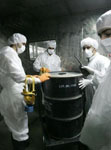 AFP: Iran is pressing ahead with its controversial atomic programme, producing enriched uranium at higher levels of purification and installing more machinery, a restricted UN report revealed on Monday.
AFP: Iran is pressing ahead with its controversial atomic programme, producing enriched uranium at higher levels of purification and installing more machinery, a restricted UN report revealed on Monday.
By Simon Morgan
 VIENNA (AFP) — Iran is pressing ahead with its controversial atomic programme, producing enriched uranium at higher levels of purification and installing more machinery, a restricted UN report revealed on Monday.
VIENNA (AFP) — Iran is pressing ahead with its controversial atomic programme, producing enriched uranium at higher levels of purification and installing more machinery, a restricted UN report revealed on Monday.
And the UN atomic watchdog says it remains concerned about the true nature of the nuclear activities, which Tehran insists are exclusively peaceful.
“Based on an overall analysis … of all the information available, the agency remains concerned about the possible existence in Iran of past or current undisclosed nuclear related activities, involving military related organisations,” the International Atomic Energy Agency said in a restricted report obtained by AFP.
Some of those activities were “related to the development of a nuclear payload for a missile. There are indications that certain of these activities may have continued beyond 2004,” the report said.
The watchdog said Iran — which is likely to see a fourth round of sanctions slapped on it by the United Nations Security Council later this week over its contested atomic drive — has already produced at least 5.7 kilogrammes (12.5 pounds) of higher-enriched uranium.
And Tehran has installed a second set of uranium-enriching centrifuges, which would potentially be used to produce more of the material, even if the machines are not yet operational.
“On April 7, 2010, Iran withdrew 5.7 kilogrammes of UF6 (uranium hexafluoride) from the first cascade” at its pilot fuel enrichment plant in Natanz, the report said.
“According to Iran, this UF6 was enriched to 19.7 percent.”
A senior diplomat with knowledge of the IAEA’s Iran investigation said that the real amount was actually more.
“The 5.7 kilogrammes was in early April. But it has continued to produce it since then. It’s more,” the diplomat said, speaking on condition of anonymity.
The enriched uranium, which Iran says it needs for a research reactor that makes radioisotopes for medical purposes, but which the West fears is ultimately intended for a nuclear weapon, was being produced at an estimated rate of around 100 grammes per day, the diplomat added.
Iran, which has so far been enriching uranium to levels of no more than 5.0 percent in Natanz, started enriching to close to 20 percent purification in February, ostensibly to make fuel for a research reactor in Tehran.
The move drew wide condemnation from western countries because it brings the Islamic republic closer to levels needed to make the fissile material for a nuclear bomb.
In an IAEA-brokered deal last October, the United States, Russia and France proposed they take most of Iran’s stockpile of low-enriched uranium (LEU) and turn it into the fuel rods for the research reactor.
But Iran refused to take up the offer and has drawn up an alternative deal with Brazil and Turkey instead.
And it has riled the West by insisting on enriching uranium to higher levels on its own, even though it is not believed to have the technology to turn that material into the fuel rods for the reactor.
Acccording to the IAEA report, Iran has amassed some 2,427 kilogrammes of LEU so far, double the amount it says it is ready to transfer to Turkey for further processing.
The longer Iran continues to enrich uranium, the larger its stockpile will become, and the less any fuel swap is likely to appeal to the West, since the main motivation behind such a deal would be to have a huge chunk of the LEU shipped out of the country.
Summing up, the IAEA said that while it could verify that none Iran’s declared nuclear material had been diverted, the Islamic republic “has not provided the necessary cooperation to permit the agency to confirm that all nuclear material in Iran is in peaceful activities.”
The report, circulated to IAEA member states on Monday, is set to be discussed at a meeting of the agency’s board of governors next week.


